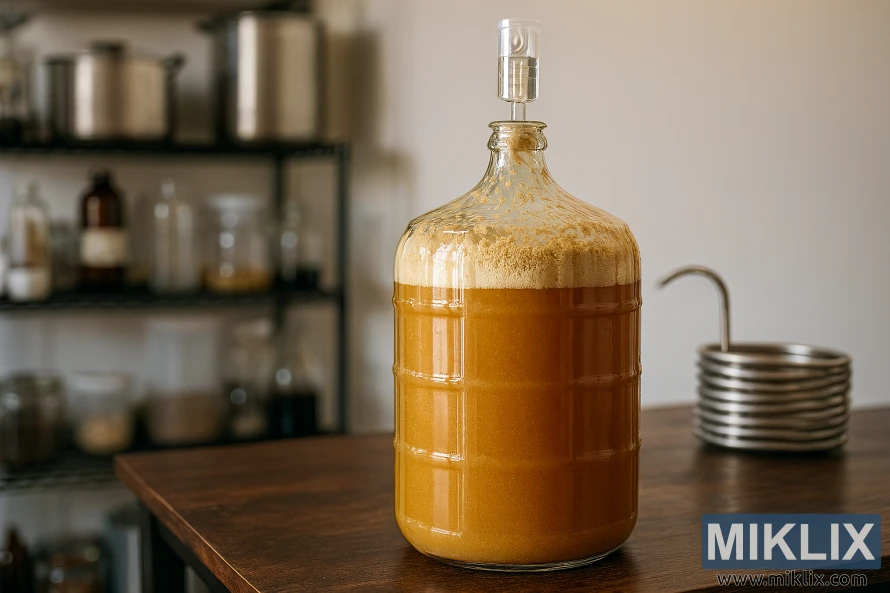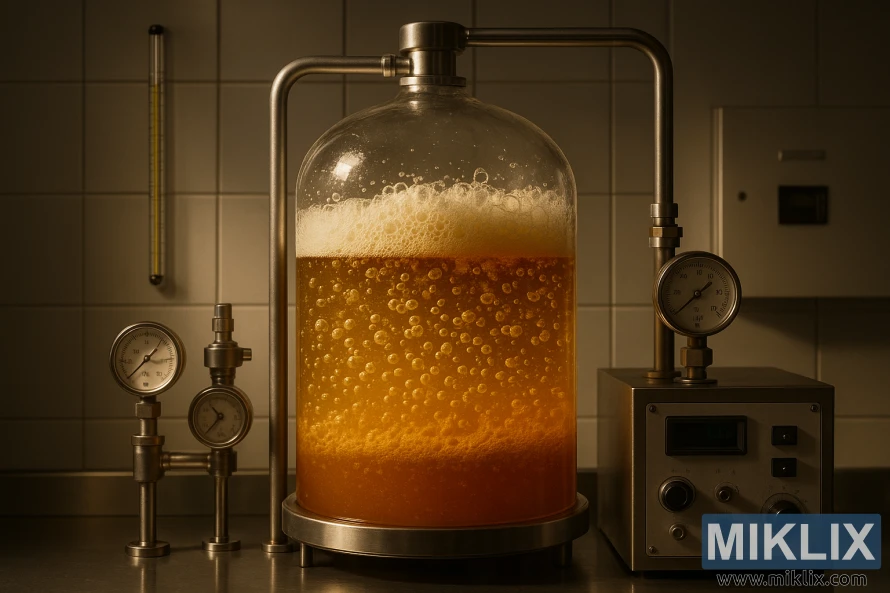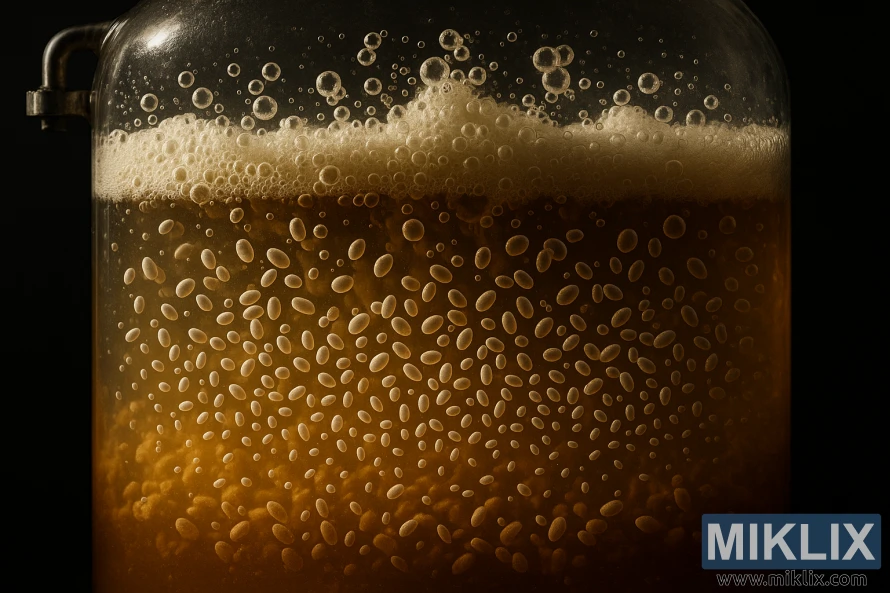Fermenting Beer with Lallemand LalBrew Verdant IPA Yeast
Published: July 21, 2025 at 10:05:47 PM UTC
Last updated: November 30, 2025 at 12:52:04 AM UTC
Creating the perfect IPA demands a thorough grasp of the yeast strain's role in fermentation. LalBrew Verdant IPA yeast has become a favorite among homebrewers. It's celebrated for its ability to craft a range of hop-forward and malty beers. This yeast is chosen for its medium-high attenuation, resulting in a soft, balanced malt profile. It's perfect for brewing IPAs with a fuller body than what's typical with American IPA yeast strains. LalBrew Verdant IPA yeast's unique traits give homebrewers the freedom to explore various beer styles. They can achieve the desired flavor and aroma profiles while experimenting.

Key Takeaways
- Understand the characteristics of LalBrew Verdant IPA yeast for optimal fermentation.
- Learn how to brew IPAs with balanced malt profiles using this yeast strain.
- Discover the versatility of LalBrew Verdant IPA yeast in various beer styles.
- Explore best practices for using LalBrew Verdant IPA yeast in homebrewing.
- Gain insights into the benefits of medium-high attenuation in yeast strains.
Understanding Lallemand LalBrew Verdant IPA Yeast
Lallemand LalBrew Verdant IPA Yeast is designed for fermenting IPA beers. It's a top-fermenting yeast, which means it ferments at the top of the vessel.
This yeast has a percent solids content of 93% to 96%. This high concentration suggests it's effective for fermentation. The yeast's viability is ≥5 x 10^9 CFU per gram, showing its strong vitality for brewing.
- Top-fermenting yeast suitable for IPA brewing
- High percent solids content (93%-96%)
- High viability (≥5 x 10^9 CFU/g)
Lallemand LalBrew Verdant IPA Yeast is a top choice for brewers. Its attenuation and flocculation properties enhance its fermentation performance. Knowing these properties is key to optimizing the brewing process.
- Consistent fermentation performance
- High-quality IPA beers with desired flavor profiles
- Reliable viability and vitality
By using Lallemand LalBrew Verdant IPA Yeast, brewers can produce superior IPA beers.
Technical Specifications and Performance Metrics
Understanding the technical specifications of Lallemand LalBrew Verdant IPA Yeast is key to achieving optimal brewing results. This yeast strain is engineered for high-performance fermentation. Its technical specs are vital to this process.
The Lallemand LalBrew Verdant IPA Yeast can ferment 75%-82% of the sugars in the wort. This leads to a dry finish, a hallmark of many IPA styles. Its fast flocculation rate also ensures quick settling, simplifying beer clarification.
The ideal fermentation temperature for this yeast is 18-23°C. Keeping this range is essential to avoid off-flavors and ensure optimal yeast performance. By managing the fermentation temperature, brewers can enhance the yeast's efficiency and produce superior beer.
In conclusion, Lallemand LalBrew Verdant IPA Yeast is a top pick for brewers aiming to craft high-quality IPA beers. Its high attenuation, fast flocculation, and optimal fermentation temperature range all contribute to its reliability and consistency in fermentation.
Optimal Fermentation Temperature Range
Lallemand LalBrew Verdant IPA Yeast ferments best within a specific temperature range. This range is key for producing high-quality beer. The optimal temperature range for fermentation is between 18°C to 23°C. This is critical for preventing off-flavors and ensuring the yeast performs at its best.
Maintaining the optimal fermentation temperature is essential for the desired flavor and character in beer. When the fermentation temperature is within the recommended range, the yeast ferments the beer efficiently. This results in a cleaner and more consistent flavor profile.
To achieve the best results, brewers should ensure their fermentation environment is set up to maintain a consistent temperature within the optimal range. This may involve using temperature control systems or carefully monitoring the fermentation temperature to prevent any deviations.
- Monitor fermentation temperature closely to prevent off-flavors.
- Maintain a consistent temperature between 18°C to 23°C for optimal yeast performance.
- Use temperature control systems if necessary to keep the fermentation within the recommended range.
By controlling the fermentation temperature and keeping it within the optimal range, brewers can significantly improve the quality of their beer. This attention to detail is what sets high-quality brews apart from others.

Alcohol Tolerance and Attenuation Rates
Understanding the alcohol tolerance and attenuation rates of Lallemand LalBrew Verdant IPA yeast is key to achieving desired beer characteristics. The yeast's alcohol tolerance is a critical factor in determining its suitability for various beer styles.
Lallemand LalBrew Verdant IPA yeast has an alcohol tolerance of 10%. This makes it suitable for brewing a range of beer styles, from session IPAs to more robust, full-bodied beers. This level of tolerance allows brewers to experiment with different recipes without worrying about yeast viability during fermentation.
The attenuation range of 75%-82% indicates the yeast's ability to ferment a significant portion of the sugars present in the wort. This results in a dry finish. This characteristic is beneficial for brewers aiming to produce beers with a crisp, clean taste.
In summary, the combination of high alcohol tolerance and efficient attenuation rates makes Lallemand LalBrew Verdant IPA yeast an excellent choice. It is ideal for brewers seeking to produce high-quality IPAs and other beer styles that require robust fermentation performance.
Flavor Profile and Aroma Characteristics
The Lallemand LalBrew Verdant IPA yeast is celebrated for its complex flavor and distinct aroma. It brings forth notes of apricot and undertones of tropical fruit and citrus. These flavors blend perfectly with hop aromas.
This yeast's flavor profile is both fruity and refreshing. It's ideal for brewers aiming to craft unique IPA styles. Its ability to enhance hop flavors without dominating them is a major reason for its popularity.
Some key characteristics of the Lallemand LalBrew Verdant IPA yeast's flavor profile and aroma include:
- Fruity notes of apricot and tropical fruit
- Citrus undertones that complement hop flavors
- A balanced and refreshing overall character
By understanding and leveraging these characteristics, brewers can create a wide range of IPA styles. These styles showcase the unique qualities of this yeast.
Pitch Rate Recommendations
The recommended pitch rate for Lallemand LalBrew Verdant IPA Yeast is critical for optimal fermentation. A pitch rate of 50-100g per hectoliter of wort is advised for the best results. This ensures the yeast ferments efficiently, impacting the beer's flavor and alcohol content.
Ensuring the correct yeast pitch is essential. It guarantees enough yeast cells to ferment the beer well. This is vital for achieving the desired flavor and alcohol levels. Under-pitching can cause incomplete fermentation, leading to off-flavors and inconsistent quality.
To determine the optimal pitch rate, brewers must consider several factors. These include the wort's specific gravity, the desired fermentation temperature, and the yeast strain's characteristics. Lallemand LalBrew Verdant IPA Yeast is designed for fermentation at a pitch rate of 50-100g/hL. This makes it suitable for a wide range of brewing applications.
Following the recommended pitch rate ensures efficient and consistent fermentation. This leads to higher quality beer. Proper pitching techniques and rates are key to successful brewing.
- Pitch rate affects fermentation efficiency and beer quality.
- Lallemand LalBrew Verdant IPA Yeast recommends 50-100g/hL pitch rate.
- Proper pitching ensures consistent fermentation outcomes.

Starter Culture Preparation Methods
Creating a starter culture is vital for successful fermentation with Lallemand LalBrew Verdant IPA yeast. This process involves several key steps to ensure optimal fermentation performance. These steps are critical for achieving the desired results.
To start, the yeast can be rehydrated in sterile water before pitching. Using a rehydration nutrient like Go-Ferm Protect Evolution can significantly improve fermentation performance. It provides the necessary nutrients for the yeast to thrive.
- Rehydrating the yeast in sterile water at a temperature between 90°F and 100°F (32°C to 38°C).
- Adding a rehydration nutrient to the water to enhance yeast viability and performance.
- Gently stirring the mixture to ensure the yeast is fully incorporated.
- Allowing the yeast to rehydrate for a specified period, typically around 15 to 20 minutes.
By following these steps and using the right materials, brewers can create a healthy starter culture. This culture is essential for a successful fermentation process.
Fermentation Timeline and Expectations
Understanding the fermentation process is key to achieving top-notch results with Lallemand LalBrew Verdant IPA yeast. Fermentation can wrap up in just 5 days. Yet, several elements shape the overall journey.
The lag phase, total fermentation time, attenuation, and flavor profile hinge on several factors. These include pitch rate, yeast handling, fermentation temperature, and the wort's nutritional quality. Brewers must manage these carefully to hit their goals.
To guarantee a successful fermentation, brewers need to keep a close eye on the process. Important considerations include:
- Pitch rate: The rate at which yeast is added to the wort impacts fermentation time and flavor profile.
- Yeast handling: Proper handling of yeast is critical for maintaining its viability and ensuring a healthy fermentation.
- Fermentation temperature: Temperature control is vital for achieving the optimal fermentation conditions.
- Nutritional quality of the wort: The nutritional quality of the wort impacts yeast health and fermentation performance.
By grasping the fermentation timeline and expectations, brewers can fine-tune their brewing process. This leads to the creation of high-quality beers with Lallemand LalBrew Verdant IPA yeast.
Compatible Beer Styles
Lallemand LalBrew Verdant IPA yeast offers a unique edge for brewing a variety of beer styles. From IPAs to Sours, its versatility is unmatched.
This yeast strain is ideal for crafting New England IPA (NEIPA), English IPA, American Pale, English Bitter, Sweet Stout, and Sours. Its adaptability makes it a favorite among brewers looking to explore different styles.
NEIPA, celebrated for its hazy look and fruity taste, pairs perfectly with Lallemand LalBrew Verdant IPA yeast. The yeast amplifies the beer's fruitiness and contributes to its signature haze.
For English IPA, the yeast ensures balanced fermentation, resulting in a beer with a rich, malty flavor and a crisp finish. American Pale Ale brewers will find the yeast's consistent fermentation beneficial, producing a clean, refreshing beer.
- NEIPA: Enhances fruitiness and contributes to haze
- English IPA: Balanced fermentation for rich, malty flavor
- American Pale: Consistent fermentation for clean taste
- English Bitter: Complex flavor profile
- Sweet Stout: Smooth, creamy texture
- Sours: Versatile for kettle souring or wild fermentation
The Lallemand LalBrew Verdant IPA yeast is a versatile tool in the brewer's toolkit. It allows for the creation of a wide range of beer styles with consistent quality.
Comparing Performance with Other IPA Yeasts
For brewers aiming to enhance their beer's taste, comparing IPA yeasts is essential. Lallemand LalBrew Verdant IPA yeast is crafted to deliver complex, balanced hop flavors. But how does it compare to other popular IPA yeasts?
Several factors are important when comparing Lallemand LalBrew Verdant IPA yeast to others. These include fermentation temperature, alcohol tolerance, and attenuation rates. For example, some yeasts might tolerate more alcohol but may lack in flavor complexity.
Lallemand LalBrew Verdant IPA yeast stands out for its ability to ferment at a broad range of temperatures. This versatility is beneficial for various brewing setups. It also has a balanced attenuation rate, ensuring the beer's sugars are fully consumed. This prevents unwanted residual sweetness.
- Offers complex and balanced hop flavors
- Wide fermentation temperature range
- Balanced attenuation rate
In summary, Lallemand LalBrew Verdant IPA yeast is a strong contender for brewers aiming to craft unique IPA beers. Its distinct characteristics and performance metrics make it a valuable choice for achieving specific flavor profiles.
Storage and Viability Guidelines
Ensuring optimal performance requires the right storage conditions for Lallemand LalBrew Verdant IPA Yeast. Proper storage and handling are key to maintaining its viability and effectiveness in brewing.
The yeast must be stored in a vacuum-sealed package to prevent air exposure. This exposure can cause rapid loss of activity. It's advised to store it in dry conditions at a temperature below 4°C. Such storage preserves the yeast's viability.
Handling the yeast in a clean, sanitary environment is also critical. This includes rehydrating and pitching it under the right conditions. This ensures optimal fermentation performance.
- Store in a vacuum-sealed package.
- Keep in dry conditions.
- Maintain a temperature below 4°C.
- Handle in a clean and sanitary environment.
By adhering to these guidelines, brewers can ensure Lallemand LalBrew Verdant IPA Yeast remains viable. This yeast will perform well during fermentation. Proper storage and handling practices are essential for consistent, high-quality brewing results.
Troubleshooting Common Issues
Effective troubleshooting is essential for overcoming common issues in beer fermentation with Lallemand LalBrew Verdant IPA yeast. These issues include slow fermentation, off-flavors, and poor attenuation.
To tackle these problems, brewers should first assess the pitch rate. Under-pitching can cause slow or stuck fermentation. It's also vital to handle the yeast correctly. Excessive heat or cold stress during storage and rehydration can harm yeast viability and performance.
Monitoring fermentation temperature is another critical step. Lallemand LalBrew Verdant IPA yeast thrives within a specific temperature range. Deviations can lead to undesirable flavors or fermentation issues. The nutritional quality of the wort also significantly impacts yeast performance. Deficient wort nutrients can result in poor attenuation or off-flavors.
Here are some common issues and their solutions:
- Slow Fermentation: Check the pitch rate, ensure proper yeast handling, and verify that fermentation temperatures are within the optimal range.
- Off-Flavors: Review yeast handling practices, check for contamination, and ensure that the wort's nutritional profile is adequate.
- Poor Attenuation: Verify that the wort has sufficient nutrients, check fermentation temperatures, and ensure that the yeast is healthy and properly pitched.
By systematically checking these causes, brewers can identify and address issues that may arise during fermentation with Lallemand LalBrew Verdant IPA yeast. This ensures a successful brewing process.

Advanced Brewing Techniques
Lallemand LalBrew Verdant IPA yeast opens doors to experimenting with advanced brewing methods. Techniques like re-pitching and yeast blending allow for unique beer profiles. These methods help brewers refine their fermentation outcomes.
Re-pitching uses yeast from previous batches, cutting costs and ensuring consistency. Yet, it's vital to check yeast health before reusing it. This prevents contamination and fermentation problems.
Yeast blending mixes different strains for a distinct fermentation profile. This method combines the strengths of various yeasts, like Lallemand LalBrew Verdant IPA, to craft complex beers.
In yeast blending, brewers must consider each strain's characteristics and how they'll interact. For instance, blending a yeast known for esters with a neutral one can result in a balanced flavor.
- Monitor yeast health and viability before re-pitching.
- Select yeast strains that complement each other in blending.
- Maintain strict sanitation practices to avoid contamination.
Advanced brewing techniques, such as re-pitching and yeast blending, can elevate beer quality. The Lallemand LalBrew Verdant IPA yeast is a versatile tool for brewers aiming to innovate and perfect their craft.
Commercial Brewery Applications
Commercial breweries can greatly benefit from Lallemand LalBrew Verdant IPA yeast for large-scale fermentation and packaging. This yeast strain is crafted to provide consistent performance and high-quality IPA beers. It's perfect for breweries aiming to increase their production.
For commercial use, maintaining consistency and quality is essential. This means careful management of fermentation conditions. This includes controlling temperature and nutrient supply to ensure the yeast performs optimally.
The steps to scale up fermentation and packaging with Lallemand LalBrew Verdant IPA yeast include:
- Preparing starter cultures to achieve the desired pitching rate
- Monitoring fermentation temperature and specific gravity to ensure optimal attenuation
- Managing yeast harvesting and re-pitching for subsequent brews
- Implementing quality control measures to maintain consistency across batches
By adhering to these guidelines, commercial breweries can harness the advantages of Lallemand LalBrew Verdant IPA yeast. They can produce high-quality IPA beers that meet consumer expectations.
Cost-Benefit Analysis and Value Proposition
When evaluating Lallemand LalBrew Verdant IPA yeast, several key factors are important. The yeast's performance, versatility, and compatibility with different beer styles are critical. These elements determine its overall value to brewers.
The Lallemand LalBrew Verdant IPA yeast is designed for high attenuation and consistent fermentation. This directly impacts the quality and character of the final beer. Its ability to produce beers with complex flavors and aromas makes it appealing for breweries aiming to create unique IPA styles.
From a cost viewpoint, using this yeast can lead to significant savings. Reduced fermentation times and improved batch consistency are key. These benefits can lower production costs and speed up the process from brewhouse to packaging.
The yeast's value is further enhanced by its compatibility with various brewing conditions and styles. Whether breweries are making session IPAs or double IPAs, Lallemand LalBrew Verdant IPA yeast offers the flexibility and performance needed. This ensures breweries can achieve their desired outcomes.
- Consistent fermentation performance
- High attenuation rates
- Compatibility with various IPA styles
In conclusion, the cost-benefit analysis of Lallemand LalBrew Verdant IPA yeast shows a compelling value proposition for breweries. It offers a combination of performance, versatility, and cost-effectiveness. This makes it well-suited for modern breweries aiming to produce high-quality IPA beers.

Conclusion
Lallemand LalBrew Verdant IPA yeast stands out as a versatile and high-performing strain. It's a favorite among brewers for its ability to craft a variety of beer styles. This article has explored its unique traits and benefits, giving a detailed look at its uses and value.
Summing up, this yeast ensures a reliable fermentation process, leading to high-quality beers with unique flavors. By mastering the optimal fermentation temperature, alcohol tolerance, and attenuation rates, brewers can fully exploit this yeast's capabilities.
In summary, Lallemand LalBrew Verdant IPA yeast is a key asset for brewers aiming to produce a range of beers consistently. Its flexibility with different styles and brewing methods makes it a top choice for both commercial and craft breweries.
Further Reading
If you enjoyed this post, you may also like these suggestions:
- Fermenting Beer with White Labs WLP036 Dusseldorf Alt Ale Yeast
- Fermenting Beer with Fermentis SafAle K-97 Yeast
- Fermenting Beer with Fermentis SafAle F-2 Yeast
